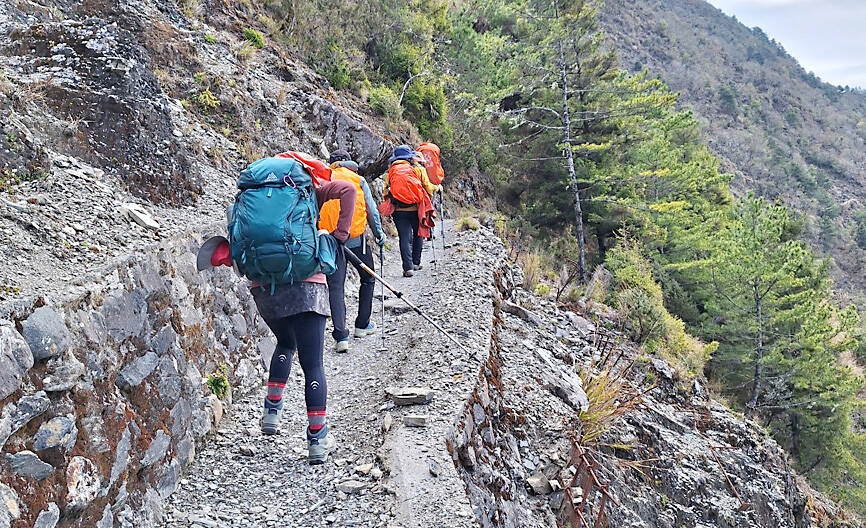Nine incidents, such as altitude sickness, have occurred on Yushan (Jade Mountain, 玉山) in the first half of this month, the Yushan National Park Headquarters said on Sunday, prompting it to issue advice and cautions.
Most areas of the park are at an altitude of 2,500m or higher where temperatures are close to 0°C or below 0°C in the evening due to a recent cold air mass, the headquarters said.
Hikers are advised to adapt their bodies to the high-altitude environment and to do warm-up exercises before the hike, it said.

Photo courtesy of Yushan National Park Headquarters
As the weather changes fast in the mountains, the headquarters recommended that hikers follow the three-layered principle of dressing — breathable and sweat-wicking underwear as the base layer, warm clothing for the middle layer and a waterproof, wind-resistant jacket for the outer layer.
Hikers dressed in three layers while setting out in the early morning can take off the outer or middle layers as they sweat during the hike to prevent the base layer from getting wet, it said.
However, they should put the middle or outer layers on again while walking under the shade of trees or taking a long rest, as chilly winds can cause altitude sickness, the headquarters said.
People with the three highs — high blood pressure, blood sugar and cholesterol — should be careful due to their health conditions and stay warm, as low temperatures could cause vasoconstriction, it said, adding that they should undergo health checks before going on the hike.
Separately, the Nantou County Cian Shan Social Welfare Charitable Foundation on Saturday donated portable altitude chambers (PACs) to the park, which can be used to help relieve symptoms of high-altitude sickness.
Altitude sickness occurs when people move too quickly from low-lying areas to places that are 2,500m or higher above sea level, where oxygen levels in the atmosphere are lower, the headquarters said.
Common symptoms of altitude sickness include headache, nausea, vomiting, fatigue, dizziness and loss of balance, which could turn into life-threatening conditions such as high-altitude cerebral edema or high-altitude pulmonary edema if the person does not descend and seek proper treatment, it said.
A safe and effective way to alleviate altitude sickness is to put the affected person in a PAC and then move them to an altitude that is lower than 2,000m, the headquarters said.
The PAC works by increasing pressure inside the chamber by inflating it from outside, it said.
Boosting air pressure simulates descent, so oxygen levels would rise again and the person would feel better, it added.
The PACs are stored in a red or blue container at 18 locations in the park, including Paiyun Lodge (排雲山莊), Guangao Lodge (觀高山屋, under construction) and other mountain cabins, it said.
They also come with an instruction manual, it added.
Hikers are encouraged to learn how to use the PAC by taking courses at hiking clubs or rescue organizations to equip themselves with the skills to help people with altitude sickness, the headquarters said.

CAUTION: Based on intelligence from the nation’s security agencies, MOFA has cautioned Taiwanese travelers about heightened safety risks in China-friendly countries The Ministry of Foreign Affairs (MOFA) yesterday urged Taiwanese to be aware of their safety when traveling abroad, especially in countries that are friendly to China. China in June last year issued 22 guidelines that allow its courts to try in absentia and sentence to death so-called “diehard” Taiwanese independence activists, even though Chinese courts have no jurisdiction in Taiwan. Late last month, a senior Chinese official gave closed-door instructions to state security units to implement the guidelines in countries friendly to China, a government memo and a senior Taiwan security official said, based on information gathered by Taiwan’s intelligence agency. The

The National Immigration Agency (NIA) said yesterday that it will revoke the dependent-based residence permit of a Chinese social media influencer who reportedly “openly advocated for [China’s] unification through military force” with Taiwan. The Chinese national, identified by her surname Liu (劉), will have her residence permit revoked in accordance with Article 14 of the “Measures for the permission of family- based residence, long-term residence and settlement of people from the Mainland Area in the Taiwan Area,” the NIA said in a news release. The agency explained it received reports that Liu made “unifying Taiwan through military force” statements on her online

Taiwan Semiconductor Manufacturing Co (TSMC), the world’s largest contract chipmaker, said yesterday that it is looking to hire 8,000 people this year, at a time when the tech giant is expanding production capacity to maintain its lead over competitors. To attract talent, TSMC would launch a large-scale recruitment campaign on campuses across Taiwan, where a newly recruited engineer with a master’s degree could expect to receive an average salary of NT$2.2 million (US$60,912), which is much higher than the 2023 national average of NT$709,000 for those in the same category, according to government statistics. TSMC, which accounted for more than 60 percent

A magnitude 5.7 earthquake struck off Taitung County at 1:09pm today, the Central Weather Administration (CWA) said. The hypocenter was 53km northeast of Taitung County Hall at a depth of 12.5km, CWA data showed. The intensity of the quake, which gauges the actual effect of a seismic event, measured 4 in Taitung County and Hualien County on Taiwan's seven-tier intensity scale, the data showed. The quake had an intensity of 3 in Nantou County, Chiayi County, Yunlin County, Kaohsiung and Tainan, the data showed. There were no immediate reports of damage following the quake.